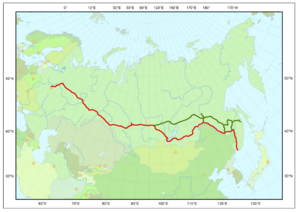Chinese Eastern Railway
The Chinese Eastern Railway or CER (also known as the Chinese Far East Railway) was a railway in northeastern China (Manchuria). It connected Chita and the Russian Far East. English-speakers have sometimes referred to this line as the Manchurian Railway. Russians know it as «Кита́йско-Восто́чная Желе́зная Доро́га», or КВЖД (Kitaysko-Vostochnaya Zheleznaya Doroga, KVZhD).
The southern branch of the CER, known in the West as the South Manchuria Railway, became the locus and partial casus belli for the Russo-Japanese War and the Second Sino-Japanese War (including incidents leading up to the latter from 1927).
The administration of the CER and the Chinese Eastern Railway Zone was based in Harbin.
History of the line

The Chinese Eastern Railway was a single tracked line extending (and shortening) the famous world's longest railroad, the Trans-Siberian Railway from near the Siberian city of Chita via Harbin across northern inner Manchuria to the Russian port of Vladivostok. This route drastically reduced the travel distance required along the original main northern route to Vladivostok (this original route lay completely outside China).
A construction concession was granted by China in 1896 through northern Inner Manchuria, running from near Chita via Harbin to Vladivostok, and construction was drastically accelerated after Russia concluded a twenty-five year lease of Liaodong from China.
Construction of the CER started in July 1897 along the line Tarskaya (east of Chita) - Hailar - Harbin - Nikolsk-Ussuriski. Officially, traffic on the line started in November 1901, but regular passenger traffic from St. Petersburg to Vladivostok across the Trans-Siberian railway started in July 1903.
At this same time in 1898, a 550 mile spur line, most which later formed the South Manchuria Railway, was started from Harbin down through eastern Manchuria, along the Liaodong Peninsula, to the ice-free deep water port at Lüshun, a town almost at the tip of the peninsula, which Russia was fortifying and overhauling into a first class strategic naval base and marine coaling station for their Far Seas Fleet and Merchant Marine. This town was known in the west as Port Arthur, and the Russo-Japanese War (1904-1905) was essentially fought over who would possess this region and its excellent harbor, as well as whether it would remain open to traders of all nations (Open Door Policy).
The Chinese Eastern Railway was essentially completed in 1902, beating the stretch around Lake Baikal, by fourteen years. Until that portion was completed, cargo on the Trans-Siberian Railway had to be transshipped by ferry the 632 miles along the lake's length.
During the Russo-Japanese War, Russia lost both Liaodong Peninsula and much of the South Manchurian branch to Japan. The rail line from from Changchun to Lüshun transferred to the Japanese control now became the South Manchuria Railway.
During 1917-1924 (Russian Civil War) the Russian part of the CER came under the administration of the White Army.
After 1924, the USSR and China administered the Northern CER jointly, while Japan maintained control of the southern spurline.
The Sino-Soviet conflict of 1929 was fought over the administration of the Northern CER.
In 1935, the USSR had to sell all its rights in the CER to the Manzhouguo government.
From August 1945, the CER again came under the joint control of the USSR and China. Somewhat reversing their stinging losses in 1904-1905, after World War II the Soviet Government insisted on occupying the Liaodong Peninsula but allowed joint control over the Southern branch with China; all this together received the name of the "Chinese Changchun Railway" (Russian: Кита́йская Чанчу́ньская желе́зная доро́га).
In 1952, the Soviet Union transferred (free of charge) all its rights to the Chinese Changchun Railway to the People's Republic of China.
See also
References
- Mara Moustafine. Secrets and Spies: The Harbin Files. A Vintage Book series, Random House, Australia Pty Ltd, 468 pp.
- F.R. Sedwick, (R.F.A.), The Russo-Japanese War, 1909, The Macmillan Company, N.Y., 192 pp.
- Colliers (Ed.), The Russo-Japanese War, 1904, P.F. Collier & Son, New York, 128 pp.
External link
eo:Ĉina orienta fervojo ja:東清鉄道 ru:Китайско-Восточная железная дорога zh:東清鐵路
